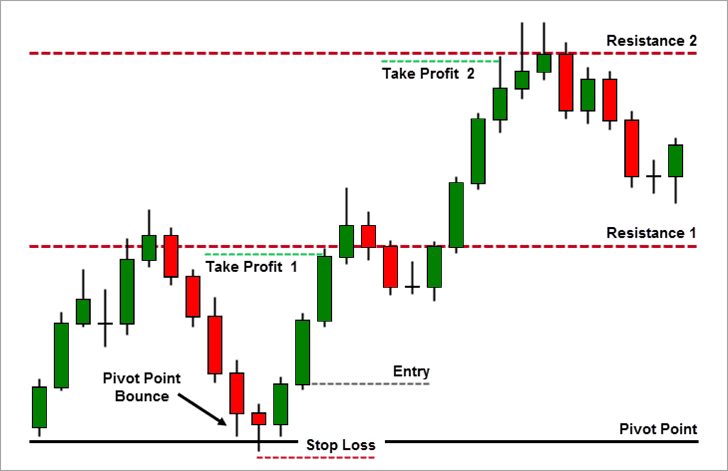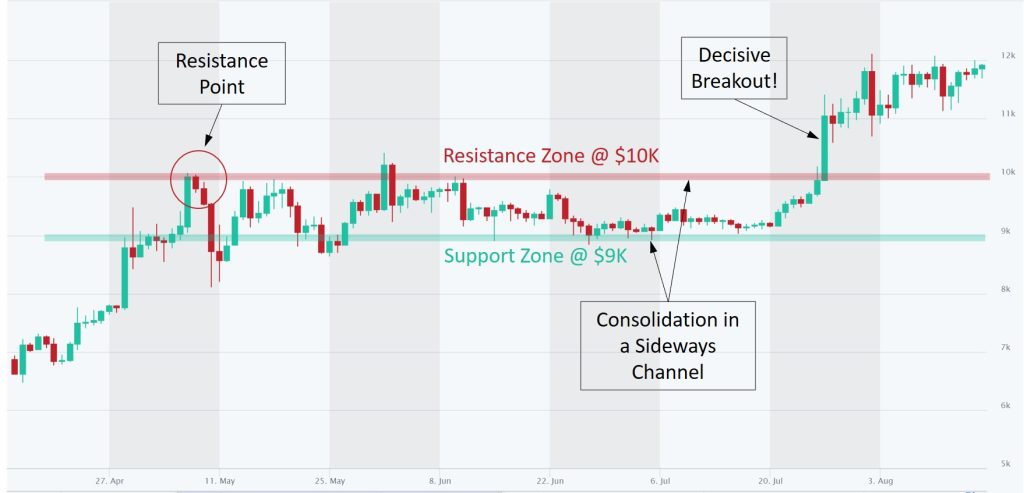
Every trader should be familiar with the fundamental ideas of support and resistance in technical analysis. These ideas are essential for determining future price levels where buying or selling pressure may develop, changing the direction of trends, or continuing them. In this article, we’ll look at the principles of support and resistance, see how to spot them on price charts and learn how to build profitable trading systems around these crucial levels.
Understanding Support and Resistance
Support
Prices decline during a downturn when there is an excess of supply compared to demand. For those holding out to purchase shares, prices get more appealing the lower they go. Demand that has been gradually rising will eventually reach the point where supply and demand are equal. Prices will then stop decreasing. This is assistance.
Support can be a price zone or a price level on the chart. In any case, support is a region on a price chart that displays the readiness of buyers to purchase. Demand will typically outpace supply at this point, halting the price decrease and starting it back up again.
Resistance
The opposite of support is resistance. Because there is a greater demand than there is supply, prices rise. There will come a time when prices rise when the desire to sell will outweigh the desire to acquire. There are several reasons why this occurs. It’s possible that traders have decided that the price is too high or their goal has been reached. Purchasers might be reluctant to start new positions at such high valuations. It may be for a variety of different reasons. However, a technician can easily identify the point on a price chart where supply outweighs demand. This is opposition. It might be a level or a zone, just like support.
Support and resistance levels can be identified using various methods, such as trendlines, horizontal lines, moving averages, Fibonacci retracement levels, and pivot points. These levels represent areas where traders are likely to step in or exit positions due to previous market behavior.

The above gives you a simple understanding, support, and resistance. These terms are what technical analysts call barriers. It plays a role in preventing an asset class from being pushed in a certain direction.
For long-time traders or investors, it is a familiar concept. But newcomers to the market are very important concepts. Discussed a lot in technical analysis.
Identifying Support and Resistance Levels
Trendlines
Trendlines are one of the most common tools for identifying support and resistance levels. An uptrend line connects consecutive higher swing lows, acting as support. Conversely, a downtrend line connects consecutive lower swing highs, acting as resistance.
To draw trendlines effectively:
- Identify at least two significant swing lows for an uptrend line.
- Connect the swing lows with a straight line.
- Extend the trendline into the future to anticipate potential support levels.
- Repeat this process for downtrends but connect swing highs instead.

Horizontal Lines
Every trader should understand the fundamental concepts of support and resistance in technical analysis. These concepts are crucial for determining potential price levels where buying or selling pressure may arise, changing trends’ directions, or maintaining them. In this piece, we’ll examine the fundamentals of support and resistance, learn to identify them on price charts and develop winning trading strategies based on these key levels.
Moving Averages

Trading professionals frequently utilize moving averages to pinpoint areas of support and resistance. The 50-day and 200-day moving averages are the two most popular varieties. These moving averages frequently serve as support or resistance as the price approaches them, depending on the trend.
The 200-day moving average is regarded as a long-term indicator, while the 50-day moving average is short-term. In order to confirm probable support or resistance zones, traders seek convergence between these moving averages and other technical tools.
Fibonacci Retracement Levels
Mathematical ratios generated from the Fibonacci sequence are the foundation for Fibonacci retracement levels. During price retracements inside a bigger trend, these levels aid traders in locating probable levels of support and resistance.
To use Fibonacci retracement levels effectively:
- Identify the high and low of the recent trend.
- Draw horizontal lines at specific Fibonacci ratios: 23.6%, 38.2%, 50%, 61.8%, and 78.6%.
- These levels act as potential areas where prices may retrace before continuing in the direction of the trend.
Pivot Points
Finding intraday levels of support and resistance can be done using pivot points. They are determined using the prior day’s high, low, and close prices.
The important pivot point is the average of those three prices, and additional support and resistance levels are calculated using mathematical formulas from this pivot point. When confirming probable buy or sell zones, traders frequently employ pivot points with other technical indicators.

Trading Strategies Based on Support and Resistance
Support Breakout Strategy
A support breakout strategy involves trading the break of a support level. When a stock or any other asset breaks below a support level, it indicates a potential shift in market sentiment from bullish to bearish.
To execute this strategy effectively:
- Identify a strong support level that has been tested multiple times.
- Monitor the price action for signs of weakness, such as lower highs and increasing selling volume.
- Place a sell order below the support level once it is confirmed to be broken.
- Set a stop-loss above the broken support level to limit potential losses.
- Consider taking profits near the next significant support area.
Resistance Breakout Strategy
A resistance breakout strategy involves trading the break of a resistance level. When an asset breaks above a resistance level, it suggests a potential shift in market sentiment from bearish to bullish.
To execute this strategy effectively:
- Identify a strong resistance level that has been tested multiple times.
- Look for signs of strength, such as higher lows and increasing buying volume.
- Place a buy order above the resistance level once it is confirmed to be broken.
- Set a stop-loss below the broken resistance level to manage risk.
- Consider taking profits near the next significant resistance area.

Support and Resistance Bounce Strategy
The support and resistance bounce strategy aims to profit from price reversals at these key levels.
To execute this strategy effectively:
- Identify strong support or resistance levels that have been held multiple times.
- Wait for the price to approach these levels without breaking them.
- Look for reversal candlestick patterns or other technical indicators signaling potential buying or selling pressure.
- Enter trades in the opposite direction once confirmation signals are present (e.g., bullish engulfing pattern at support).
- Set stop-loss orders below support or above resistance levels to manage risk.
- Take profits near subsequent support or resistance areas.
Related Indicators
Price charts give investors a visual representation of support and resistance areas, which are crucial in trading decisions. To better understand their significance, consider the following factors:
Number of support and resistance touches
The more times the price tests a support or resistance zone, the more critical it becomes to identify these levels accurately. When the price consistently bounces off these levels, both buyers and sellers take notice and base their trading decisions on them.
Trading volume at specific prices:
The buying and selling activity at that particular price determines the strength of a support or resistance level. Traders and investors remember these prices and often use them as reference points in future trades. If significant activity with large volumes and prices declines, many trades will likely occur when the price returns to that level. Traders may prefer to exit the trade at breakeven rather than incur losses.
Time
Support and resistance zones become even more important. That is if those levels have been tested regularly over an extended period. You wait patiently.
Conclusion
Support and resistance are essential concepts in technical analysis that can greatly assist traders in identifying potential reversal or continuation zones. By understanding how to identify these levels and implementing effective trading strategies, traders can increase their probability of success. Regular practice and observation of price action will further enhance your ability to effectively identify and trade support and resistance. Remember, no strategy is foolproof, so always apply risk management techniques to protect your capital.


